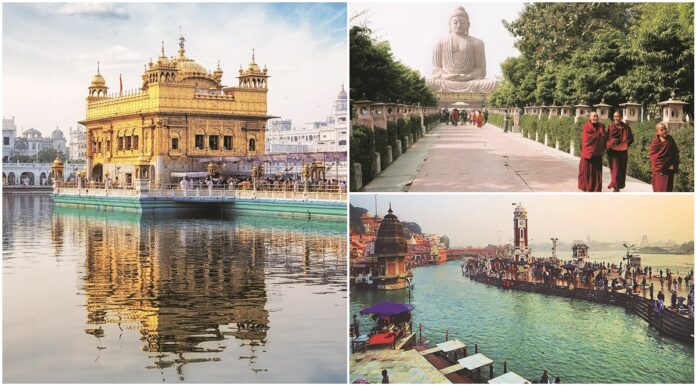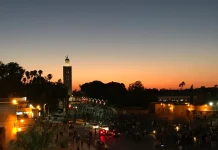Religious tours are quite popular in India—be it a yatra to Vaishno Devi temple in Katra, a visit to Tirumala’s Tirupati Balaji temple in Andhra Pradesh or a pilgrimage to Buddhist holy sites such as Bodh Gaya in Bihar and Sarnath in Uttar Pradesh, faithfuls and travel enthusiasts alike have been undertaking journeys to such places for decades. However, the past few years have witnessed a lot of activity and conversation around them, mostly due to efforts by the central and state governments and a growing interest among tourists.
While rallying for the Prime Ministerial elections in 2014, Narendra Modi had promised the construction of a Ram Temple in Ayodhya, which had received a lot of positive response from the people and was even considered one of the reasons for his success in the general elections. In February this year, Delhi CM Arvind Kejriwal made a similar move when he presented a 10-point agenda in his manifesto for Uttarakhand. During his visit to Haridwar as part of his election campaign, he promised free pilgrimage for senior citizens.
While political parties may cash in on such promises to boost and develop religious tourist circuits, the fact remains that such initiatives bring in employment opportunities for the locals. This works exceptionally well in smaller districts where the residents primarily depend on tourism as a means of livelihood. Earlier this year, the residents of Sainj Valley in Kullu district of Himachal Pradesh urged the state government to boost religious tourism to generate employment for the youth. They asked the government for better connectivity to places like Manu Rishi temple and Shanghar to attract visitors.
“There is no doubt that the initiatives undertaken by the government have encouraged travellers to explore the religious sites of India and immerse into the history and folklore associated with the destinations,” says Daniel D’souza, president and country head of travel and tourism company SOTC Travel.
On the right track
In fact, the government’s focus on tourism that has contributed to state-of-the-art infrastructure for easy accessibility and increased choice of accommodations has also led to an uptick in demand for special trains introduced by the tourism departments that cater to these pilgrimage tours, adds Rajeev Kale, president and country head – holidays, MICE, visa, Thomas Cook (India).
Kamal Bansal, chairman of Delhi government’s Tirth Yatra Vikas Samiti, shares that under the Mukhyamantri Tirth Yatra Yojana of the state government, several trains are being operated to and from religious circuits. Some of the 15 operational routes include a four-day journey from Delhi covering Mathura, Vrindavan, Agra, Fatehpur Sikri and back, a five-day trip from Delhi to Bodh Gaya, Sarnath and back, and a seven-day trip to Jagannath Puri, Konark, Bhubaneswar and back.
The Indian Railway Catering and Tourism Corporation’s (IRCTC) Shri Ramayana Yatra special train that started from Delhi on February 22 with a capacity of 132 passengers will travel a total of 7,500 km over 19 nights and 20 days covering Ayodhya, Sitamadhi, Janakpur, Varanasi, Prayagraj, Chitrakoot, Shringverpur, Nasik, Buxar, Kanchipuram and Bhadrachalam, among other places.
The Delhi government also organises camps for Kavadhs, Uttarayan, Ganesh Visarjan, Durga Puja and so on.
While the tourism industry in general suffered a huge blow during the pandemic, religious travels acted as a saving grace and helped the domestic tourism sector to recover. A spokesperson of online travel agency Yatra.com says that in the first half of 2021, tourism remained slow due to the pandemic, but religious destinations picked up in the latter half even for vacations as such tours also acted as quick getaways. “Religious tourism has advanced with offerings of multicultural experiences and tourists visiting popular destinations like the holy ghats of Varanasi. The government and various stakeholders have also been focusing on the vast potential with investment and opportunities for religious tourism,” the spokesperson adds.
Witnessing demand, several travel companies as well as state governments have been rolling out special packages. SOTC Travel has introduced various packages dedicated to its religious/spiritual traveller segment among which the ‘Ramayana Trails’ (walking in the footsteps of Lord Ram and re-living his life within India), the Jyotirlinga of Gujarat, and Kashi, Varanasi are the most popular. Yatra.com too has rolled out various holiday packages specifically for Char Dham Yatra. Thomas Cook India has ‘Jyotirlinga of Gujarat’ tours apart from the recently launched special offers for Kashi-Vishwanath in Uttar Pradesh to encourage customers to embark on their religious journey.
The department of tourism in Karnataka has also submitted a proposal, which is under review, for the development of Sri Chamundeshwari Devi Temple in Mysore under the National Mission on Pilgrimage Rejuvenation and Spiritual Heritage Augmentation Drive (PRASHAD) scheme of the Union ministry of tourism, says Sindhu B Rupesh, director of the state tourism department.
Rupesh says that the state has a lot of potential when it comes to spiritual tourism and adds that in the last two years domestic tourism has picked up. As per the Karnataka Tourism Policy 2020-26, spiritual tourism is one of the six themes identified for development of the tourism circuit in the state.
As for the heartland of India, on March 1, on the occasion of Maha Shivratri, the Madhya Pradesh government created a Guinness world record by lighting 2.1 million lamps in Ujjain at the Mahakaleshwar temple. The shrine that houses 12 major Jyotirlingas of Lord Shiva attracts huge crowds throughout the year. Understandably, Ujjain is also called the ‘city of Mahadev’. Praising the successful execution, MP chief minister Shivraj Singh Chouhan said that the 11 road projects inaugurated recently by Union minister Nitin Gadkari will put Ujjain on the map of religious tourism capitals in India.
Last year, Assam CM Himanta Biswa Sarma had announced the development of a religious tourist circuit that will cover all the places that were travelled by 15th-century Vaishnavite scholar Srimanta Sankardev.
According to Federation of Associations in Indian Tourism and Hospitality (FAITH) vision document India Tourism Vision 2035, India has the potential to grow in Buddhist circuit and heritage tourism, among other sectors. It states that the Tourism Vision will lead to employment of around 150 million Indians. In terms of numbers, the report suggests that 87.5 million direct and indirect jobs were created due to tourism, accounting for 12.75% of the total jobs created in the country in 2019 and that there were 2.32 billion domestic tourist visits to states and union territories in the same year, representing a resilient domestic base.
Undoubtedly, the state governments are positive about the future of religious tourism and the impact it is likely to have on the Indian economy and relations with other countries. At the ongoing Expo 2020 Dubai, Rupinder Brar, additional DG in the Union ministry of tourism said that “India has the opportunity and potential to become a hub for spiritual and religious tourism, as the government is geared up and focused towards showcasing the strength of the religions and philosophies of the country to the world.”
During the virtual session on the ‘Investment Opportunities in Travel, Tourism and Hospitality’ held during the ‘Tourism Fortnight’ at the India Pavilion, she further added that despite the pandemic, India saw an inflow of $2.93 billion of investment in tourism, as compared to $1.07 billion in the financial year 2019.
Sachin Ramchandra Jadhav, director of Odisha tourism department, also made a case for boosting religious tourism adding that “it is one of the key sectors for the state. It has a diverse tourism offering, starting from religious places to coastlines and wetlands to wildlife”. In fact, with the government’s emphasis on developing Uttar Pradesh as the major religious tourist circuit, Gorakhpur, Prayagraj, Ayodhya, Varanasi and Vindhyachal are being touted as the ‘golden pentagon’—destinations for experiential and religious tourism.
After the BJP’s obsession with developing Ram Janmabhoomi, the next in line lies the plans for the development of the Krishna Janmabhoomi circuit with Mathura and Vrindavan being taken up for extensive religious makeovers, and with the season of the elections, that becomes one of the major manifestos of the Yogi government.
Last year, adding to the Hindu religious circuits, PM Modi had inaugurated the phase-1 of the Kashi Vishwanath corridor, the foundation stone of which was laid in 2019. The construction is being undertaken at the cost of Rs 339 crore.
In 2020, the Yogi government had sent proposals to the state government to constitute Naimish, Vindhya, Shukrdham, Chitrakoot, Devipatan pilgrimage councils to boost religious tourism in these areas. The move came after the formation of Braj Teerth Vikas Parishad. The culture and tourism department of the state had been asked to make action plans to renovate ancient temples to strengthen the religious circuit there. The proposal was accepted, and the efforts are on to have a Ramayana Circuit, Braj Circuit, Mahabharata Circuit, Shaktipeeth circuit, Adhyatmik Circuit, Jain and Buddhist Circuit.
While Hindu pilgrimage centres are gaining traction, thanks to political strategies and governmental push, Buddhist and Jain circuits are next in priority for the government to attract tourism from neighbouring countries as well.
In 2018, the tourism ministry launched an initiative to develop Buddhist pilgrimage sites with the World Bank and the government of Japan. In 2019, Indigo airline announced low-budget flights to Buddhist pilgrimage centres—Gaya, Patna and Varanasi—in order to cater to the passenger traffic. The Kushinagar airport was inaugurated in October last year to boost religious tourism by connecting key Buddhist pilgrimage sites. Kushinagar, which is also the final resting place of Buddha, is an important connecting factor in the Buddhist circuit. Last year, Indian Railways too launched 5-star services for the Buddhist circuit covering Bodh Gaya, Nalanda, Sarnath, Kushinagar and Lumbini—a seven-day, eight-night itinerary.
For Sikhs, the government has identified a ‘gurdwara circuit’ to promote Sikh pilgrimages. In 2021, an 11-day journey was announced through IRCTC trains beginning and ending in Amritsar and covering Harminder Sahib in Amritsar, Patna Sahib in Patna, Hazoor Nanded Sahib in Nanded, Damdama Sahib in Bhatinda with stoppages at Saharanpur, Ambala, Ahmedabad, Surat, Jaipur, Lucknow, Manmad and so on. Earlier in 2019, the Modi government had made operational a 4.7-km visa-free corridor connecting the Indian border to Pakistan’s Gurdwara Darbar Sahib, which is the final resting place of Guru Nanak Dev, the founder of Sikhism.
India is also leaving no stone unturned to facilitate religious tourism to and from Pakistan even as the bilateral ties remain in troubled waters. Earlier this year, MEA spokesperson Arindam Bagchi stated, “As you are aware, under the 1974 Protocol between India and Pakistan, visits to religious shrines are being facilitated regularly. There is an interest on both sides to expand the agreed list of shrines and mode of travel. It naturally needs to be discussed under the protocol.”
However, what’s noteworthy is the fact that while the governments have been promising Hindu, Buddhist, Jain and Sikh circuits for tourists and seekers, few or no initiatives are being undertaken to strengthen the Christian or Muslim religious corridors. If any, the initiatives have been undertaken by private bodies.
Popular destinations
According to Yatra.com, some of the most popular religious tourist destinations in India include Vaishno Devi, Golden Temple, Tirupati Balaji, Haridwar-Rishikesh, Kashi Vishwanath, Meenakshi Temple, Venkesteswara temple, Hemkund temple, Dwarka, Bodh Gaya, Shirdi and Dakshineshwar Kali temple, among others.
Daniel D’souza of SOTC Travel adds that Amarnath Cave and Dargah Sharif, Uttar Pradesh’s Mathura, Vrindavan and Chardham in the north, Odisha’s Puri and Bihar’s Nalanda and Gaya in the east, Rajasthan’s Ajmer Sharif Dargah, Maharashtra’s Haji Ali, Goa’s St Francis Xavier and Tamil Nadu’s Rameshwaram are important religious tourist circuits as well
Rajeev Kale of Thomas Cook (India) shares that destinations like Vaishno Devi, Tirupati, Puri, and Shirdi remained hugely popular in 2021
According to Federation of Associations in Indian Tourism and Hospitality’s vision document India Tourism Vision 2035, India also has the potential to grow in Buddhist circuit and heritage tourism, among other sectors










